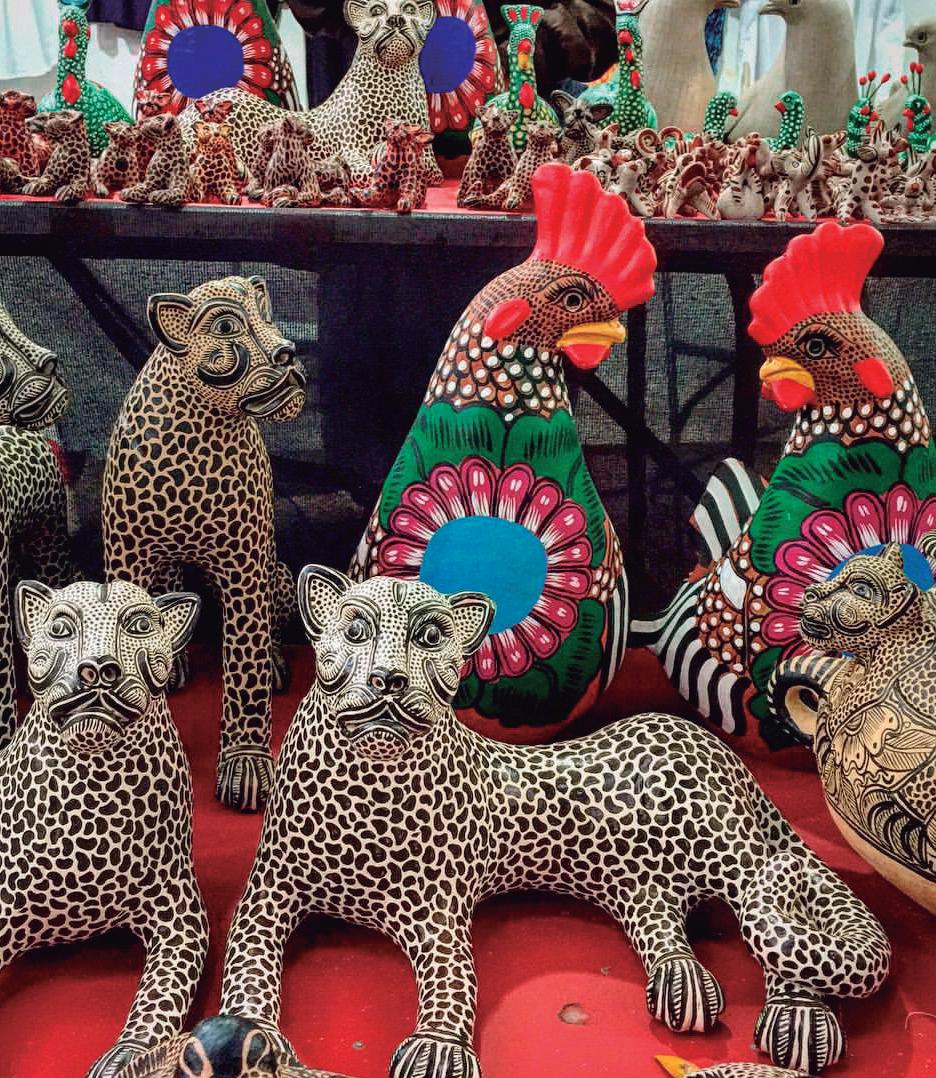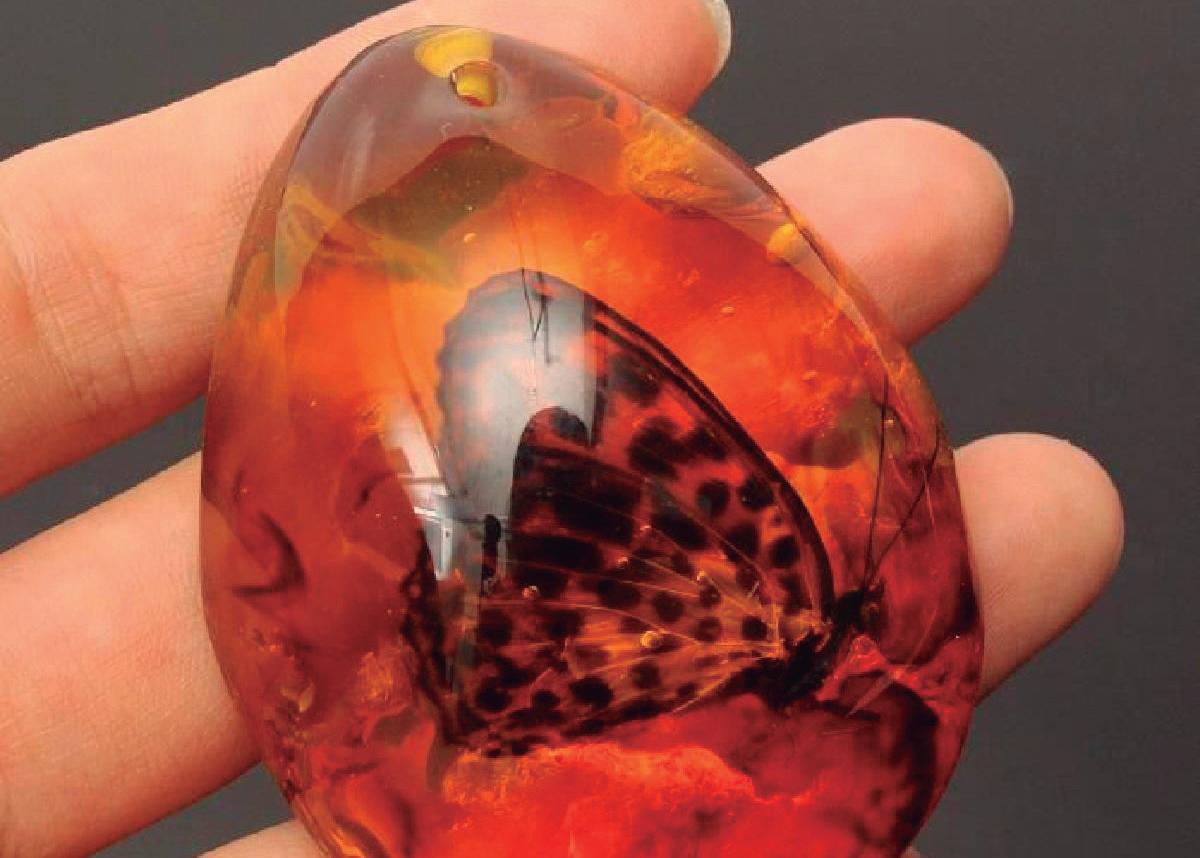
7 minute read
ARTESANÍAS DE CHIAPAS
EL ARTE
POPULAR DE CHIAPAS
Advertisement
El arte popular de Chiapas es la mejor muestra de la identidad y el orgullo de las distintas etnias del estado por su historia y sus raíces ancestrales.
The popular arts of Chiapas are the best example of the identity of the different ethnic groups of the state and the pride they feel for their history and ancient roots.

CERÁMICA
La elaboración de artículos de cerámica es una tradición que viene desde la época de la gran civilización maya. Los alfareros chiapanecos elaboran tanto utensilios de uso doméstico como cazuelas, comales, jarrones y macetas, como piezas ornamentales. El trabajo de alfarería más exquisito y mejor conocido del estado es el que elabora la comunidad tzetzal de Amatenango del Valle. Las mujeres de la comunidad aprenden desde niñas a realizar figuras que representan animales como jaguares, palomas, tortugas, soles y lunas. Los hombres se encargan del proceso de cocción, que se realiza al aire libre sobre leña, que da como resultado una cerámica color terracota claro. La alfarería chiapaneca es un arte que ha dado la vuelta al mundo, y es enormemente apreciada más allá de las fronteras de México. Simojovel de Allende es una población ubicada en la región montañosa del norte de Chiapas, conocida por producir un raro y valioso tipo de ámbar que hoy en día cuenta con denominación de origen, muy apreciado por su antigüedad y belleza, con el que los artesanos locales elaboran hermosas joyas, que pueden estar montadas en oro o plata, así como prendas ornamentales. El ámbar de Chiapas más común es de color amarillo, aunque también se le puede encontrar en tonalidades de verde, blanco, rojizo, e incluso azul, aunque las piezas más raras y valiosas son aquellas que tienen inclusiones, es decir, animales prehistóricos, más comúnmente insectos, aunque también las hay con reptiles, anfibios, e incluso aves suspendidas en el tiempo por millones de años.

The manufacturing of ceramic goods is a tradition traced to the times of the great Mayan civilization. The potters of Chiapas make domestic appliances, such as pots, skillets, vases, and flowerpots, as well as ornamental pieces. The most exquisite and best-known work is that of the Tzetzal indigenous of Amatenango del Valle. The women of the community learn when children to make figures that represent animals like jaguars, pigeons, turtles, as well as suns and moons. The men are in charge of the firing process, which they carry out on an open wood oven, obtaining a light brown ceramic as a result. The Chiapas pottery is a form of art that has traveled around the world and is greatly admired beyond the national borders. Simojovel de Allende is a town located in the northern mountainous region of Chiapas. This place is known for producing a rare and valuable type of amber, which today holds the right to use the appellation of origin. The amber of Chiapas is very appreciated for its age and beauty. The local artisans make gorgeous ornamental pieces and jewelry mounted in gold or silver. The amber of Chiapas comes most commonly in yellow, but specimens in various shades of green, white, reddish, and even blue also exist. The most valuable amber features inclusions, that is, prehistoric animals suspended in time for millions of years. The inclusions found in amber are commonly insects, but there are also reptiles, amphibians, and even birds.




TEXTILES

Una de las expresiones artísticas más famosas y celebradas de Chiapas son sus magníficos textiles. Siglos de sabiduría y tradición que han pasado de generación en generación se traducen en exquisitas telas y bordados elaborados con gran maestría, puntadas perfectas y diseños que desafían a la imaginación, con los cuales las artesanas de las distintas etnias indígenas del estado nos hablan de su historia y su rica herencia cultural. Una de las técnicas más conocidas de elaboración textil es la de telar de cintura, una herramienta cuyos orígenes se remontan a la época prehispánica y que hoy en día sigue utilizándose en distintas regiones de Mesoamérica. Los textiles y bordados se elaboran a partir de fibras naturales, como el algodón y la lana, y se tiñen con tintes extraídos de semillas, plantas e insectos desde tiempos inmemoriales. Cada grupo étnico del estado tiene sus propias técnicas de hilado, patrones de diseño y combinación de colores, lo que contribuye a la identidad de cada una de estas etnias. One of the most renowned and celebrated art expressions of Chiapas is its magnificent textiles. Centuries of wisdom and tradition have passed on from generation to generation translate into exquisite fabrics and works of embroidery made with mastery. The artisans of the different ethnic groups of the state, mostly women, tell us about their history and cultural heritage through perfect stitches and designs that defy imagination. One of the most renowned textile manufacturing tools is the waist loom. The origin of the waist loom can be traced back to the preHispanic times and weavers in different regions of Mesoamerica still use it. The textiles and embroideries are made of natural fibers, such as wool and cotton, and dyed with tints obtained from seeds, plants, and insects. Each ethnic group has its techniques, designs, patterns, and combination of colors, contributing to strengthening their identity.



Por mucho tiempo existió el debate sobre si la técnica mexicana de laqueado era originaria de los pueblos autóctonos, o si era una apropiación importada de Oriente durante la época de la colonia y el intercambio comercial con el continente asiático. Gracias a los vestigios encontrados en la Cueva de las Garrafas en Chiapas, hoy sabemos que este tipo de arte proviene en efecto de los pueblos mayas que se asentaron en el estado. El “Maque”, o laca mexicana, es un trabajo que realizan artesanos en distintas partes de México, como Michoacán o Guerrero, cada región le da a su trabajo rasgos característicos que lo distinguen de los demás. En la actualidad, la laca es el principal producto artesanal de Chiapa de Corzo, y se elabora a partir de axe, un aceite obtenido del insecto conocido como cochinilla, y colorantes naturales. El laqueado por lo regular se realiza sobre jícaras, calabazas amargas y objetos tallados en madera, y se decora con motivos florales realizados con la ayuda de las yemas de los dedos y de finos pinceles hechos de pelo de gato. En los últimos años, las lacas naturales se han visto desplazadas por los productos sintéticos, razón por la que es aún más importante conocer y valorar este exquisito trabajo tanto por su belleza como por su relevancia histórica. For a long time, the origin of the Mexican techniques of lacquer was under debate. Some specialists believed that its creation belonged to the ethnic groups of Mexico, while others believed it was an importation, appropriated during the times of the colony, where there was an intense commercial exchange between Mexico and Asia. The vestiges found in Cueva de las Garrafas in Chiapas proof that the Mayan populations that inhabited the region actually worked this type of art. The “Maque” or Mexican lacquer, is made in different states, such as Michoacán and Guerrero, and the artisans of every region have their style, which differentiates them from the rest. Today, lacquerware is the traditional craft of Chiapa de Corzo. Its main component is axe, an oil obtained from an insect known as cochineal and natural colorants. The artisans usually coat gourd shells, bitter pumpkins, and wooden objects. Most commonly, the pieces are decorated with floral patterns and painted with the fingertips and fine paintbrushes made with cat hair. In recent years, synthetic coatings have displaced natural lacquer, and this is why getting to know and value this exquisite artwork for its beauty and historical relevance is more crucial than ever.





